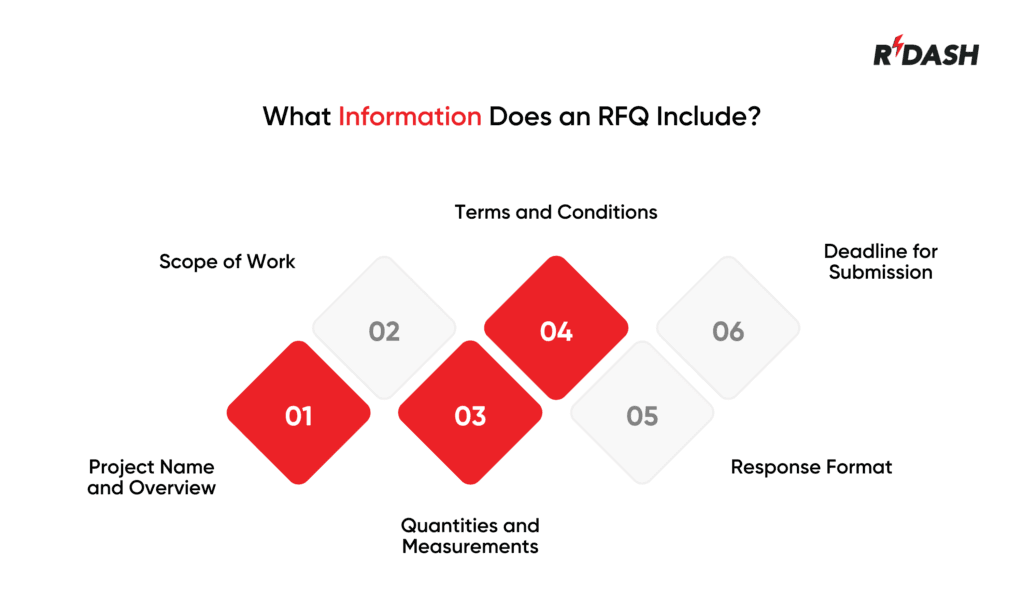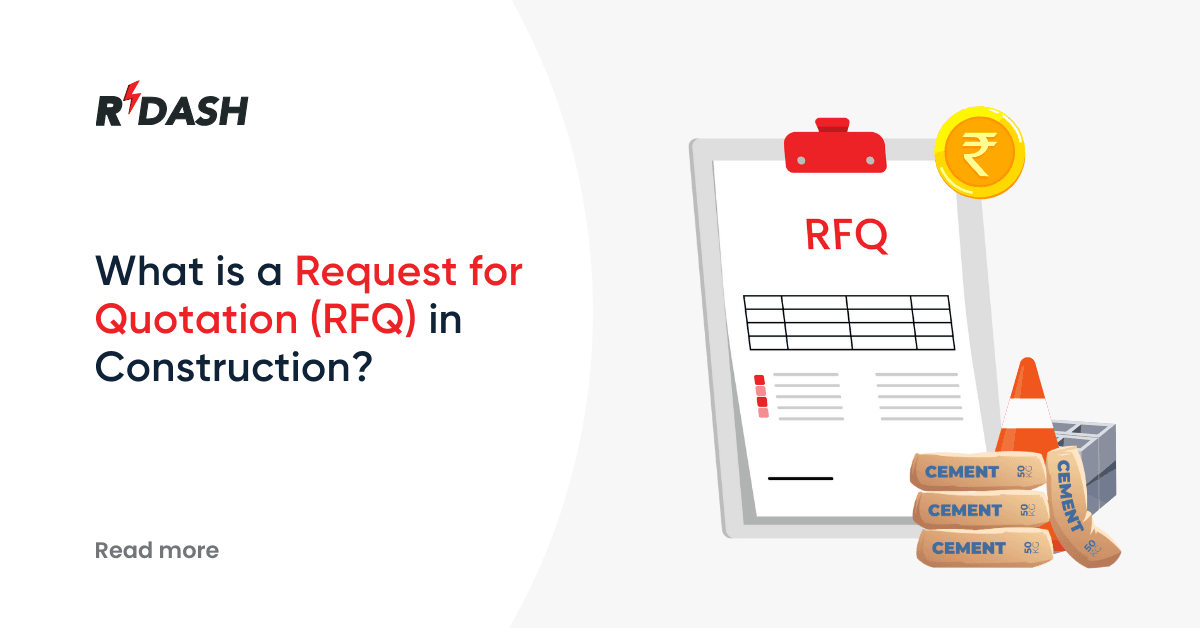What is a Request for Quotation (RFQ) in construction?
In construction, a Request for Quotation (RFQ) is a formal request shared with vendors or contractors to get price estimates for clearly defined goods or services. An RFQ is usually very detailed. It includes technical specifications, quantities, quality standards, delivery timelines, and sometimes terms and conditions. The main goal is to gather accurate price quotes from different providers so that the project owner can compare and choose the best option.
Why is Request for Quotation (RFQs) important?
Request for Quotation (RFQs) play a major role in making construction projects more organized, transparent, and cost-effective. Here’s why they are important:
Helps Control Costs
When multiple vendors submit their prices for the same work or materials, the project owner can compare the quotes and choose the most competitive offer. This ensures better use of the project budget.
Improves Transparency
RFQs create a clear, written trail of communication between the buyer and seller. This helps avoid confusion later on and ensures that everyone agrees on what is being offered and at what price.
Ensures Fair Competition
Using RFQs allows all qualified vendors to participate equally. It helps create a level playing field where all vendors can compete fairly, reducing the chance of bias or unfair preferences.
Clarifies Expectations
An RFQ clearly outlines what the buyer needs. This reduces misunderstandings, delays, or quality issues since suppliers are given full details from the beginning.
Supports Planning and Scheduling
By receiving accurate timelines along with the cost, the project team can better plan deliveries and manage construction activities. This helps in avoiding delays caused by material shortages or vendor issues.
The evolution of Request for Quotation (RFQs) in construction
In the early days, RFQs were created and shared manually. Teams had to prepare detailed documents, print them, and send them out by post or fax. The method took a lot of time and involved high expenses. Because it required a lot of effort and resources, companies were limited in how many vendors they could reach out to. As a result, they often had fewer choices and missed out on better pricing or service.
The shift to email brought a major improvement. Companies could now send RFQs to multiple suppliers quickly and at no extra cost. Communication became faster, and teams could manage responses more easily. This change made the RFQ process more flexible and encouraged competitive bidding.
Today, construction teams use modern tools like construction management software to handle RFQs more efficiently. Platforms such as Procore and others allow users to create RFQs using ready-made templates, track their progress, and manage communication in one place. These systems also notify users when a quote is received or if a vendor needs more information.
Technology has removed many of the earlier challenges. Now, information can be shared faster, tracked in real time, and organized better, leading to clearer quotes and improved vendor relationships. As tools continue to evolve, the RFQ process is becoming even smarter and more effective.
When should you use a Request for Quotation?
You should use a Request for Quotation (RFQ) when you have a clear idea of what you need and want to compare prices from different suppliers. In construction, this often happens when the project is already planned out, and the team knows the exact materials, quantities, and services required.
RFQs are useful in many situations, such as:
- When buying building materials like cement, bricks, or steel
- When hiring subcontractors for plumbing, electrical, or painting work
- When renting equipment like cranes or concrete mixers
- When outsourcing services like waste disposal or security
Using an RFQ at the right time helps you make cost-effective decisions, choose reliable vendors, and avoid delays caused by unclear requirements or unexpected expenses.
What information does a Request for Quotation (RFQ) include?
An effective Request for Quotation (RFQ) must give vendors all the details they need to provide an accurate quote. Here are the key pieces of information usually found in an RFQ:

- Project Name and Overview
A brief description of the project and what the company is requesting. - Scope of Work or Materials Needed
A clear list of items or services needed, along with technical specifications. - Quantities and Measurements
The exact amount of materials or work, so suppliers can estimate correctly. - Timeline or Delivery Dates
The timeline that outlines when the required goods or services should be provided or finished. - Terms and Conditions
Any special rules about payment, penalties, or delivery standards. - Response Format
How the vendor should reply — whether through email, a form, or a bidding portal. - Deadline for Submission
The last date by which vendors must send in their quotes.
Providing all this information makes it easier for suppliers to give accurate and comparable responses, helping the project move forward smoothly.
The RFQ process
The Request for Quotation (RFQ) process follows a step-by-step method that helps buyers get the right offers from suppliers. Here’s a simple breakdown:
1. Prepare the RFQ
The team prepares the document with all the necessary details like scope, quantities, and deadlines.
2. Send to Vendors
The RFQ is shared with selected vendors. This can be done through email or using a construction management platform.
3. Receive and Review Quotes
Vendors respond with their quotes. The team then compares prices, delivery times, and other terms.
4. Clarifications (if needed)
If anything is unclear, the team may ask vendors for more information before making a decision.
5. Select the Vendor
Once the best quote is identified, the chosen vendor is informed, and the purchase or contract process begins.
6. Recordkeeping
All responses and final decisions are documented for future reference and audits.
Following this process helps reduce risks, avoids miscommunication, and ensures the project gets the best value without wasting time or money.
Request for Quote (RFQ) vs. Request for Information (RFI)
A Request for Quote (RFQ) and a Request for Information (RFI) serve different purposes in construction, even though both are used during the procurement process.
An RFQ is used when you already know what you need and are looking for price quotes. It’s about getting costs for specific materials, services, or labor. You use an RFQ when you are ready to buy and want to compare offers from different vendors.
An RFI is typically issued at an earlier stage in the project to gather general information. You send an RFI when you’re still gathering information and trying to understand what options are available. For example, if you’re exploring new construction technologies or need help figuring out the best solution for a task, you’d send out an RFI to learn more before making any decisions.
Request for Quote (RFQ) vs. Request for Proposal (RFP)
Although RFQ and RFP may seem alike, they serve distinct purposes in different scenarios.
An RFQ is focused on pricing. You already know what you want — the materials, quantities, or services — and you just need a quote to compare vendors.
An RFP (Request for Proposal) is used when you need both pricing and a plan. In this case, the vendors are expected to offer a complete solution, which may include design ideas, methods, timelines, and costs. RFPs are common for larger or more complex jobs, like hiring a contractor to manage an entire construction project.
RFPs take more time to prepare and review because they involve both technical and financial details, while RFQs are more straightforward.
Best practices for creating effective RFQs
Writing a good Request for Quotation (RFQ) is important for getting clear and useful responses from vendors. Here are some best practices to follow:

Be Clear and Specific
Avoid vague descriptions. Be precise in your descriptions by specifying exactly what, how much, and when you require.
Use Standard Formats
Apply a uniform format to simplify the comparison of multiple quotations. Many construction software tools offer ready-made templates for RFQs.
Provide Visuals or References (if needed)
Attach drawings, images, or specifications if the item or service is complex. This helps vendors understand exactly what you are asking for.
Set a Realistic Deadline
Give vendors enough time to prepare a detailed and accurate quote. But also set a clear deadline to keep the process on track.
Allow for Questions
Let vendors ask questions if anything is unclear. It’s better to solve doubts early than face issues later.
Track and Organize Responses
Use tools or spreadsheets to track who has replied, what their offer includes, and when they can deliver. This helps make better and faster decisions.
Keep Records
Always keep a record of all RFQs and responses. This helps during audits, future projects, or if any dispute arises later.






